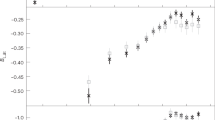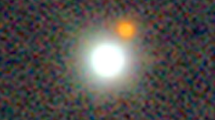Abstract
THE brightness temperature of the quiet Sun has been measured over almost the complete radio spectrum. It ranges from approximately 6,000 K at millimetre wavelengths to over 106 K at metre wavelengths. Various compilations of the disk temperatures1–3 had at centimetre and millimetre wavelengths from 10 to 100 GHz (λ=3 cm to 3 mm) (Fig. 1). A monotonically decreasing brightness temperature presented by Shimabukuro and Stacey1 from a model by van de Hulst4 is also shown in Fig. 1. Zheleznyakov5 has pointed out that the apparent dip in the observed disk temperatures near 50 GHz and at the apparent peak near 70 GHz, if real, would indicate an effective temperature inversion in the solar chromosphere from 3,000 to 3,300 km above the photosphere. Reber3, however, measured the slope of the brightness against frequency curve at 50 GHz and found that the disk temperature is, in fact, decreasing with increasing frequency in nearly perfect agreement with the van de Hulst4 model. Reber's method does not depend on an absolute measurement of the brightness temperature but rather on a relative measurement between two closely spaced frequencies, with a single instrument, thereby giving the slope with more accuracy than can be obtained by comparing a number of independent, absolute measurements.
This is a preview of subscription content, access via your institution
Access options
Subscribe to this journal
Receive 51 print issues and online access
$199.00 per year
only $3.90 per issue
Buy this article
- Purchase on Springer Link
- Instant access to full article PDF
Prices may be subject to local taxes which are calculated during checkout
Similar content being viewed by others
References
Shimabukuro, F. I., and Stacey, J. M., Astrophys. J., 152, 777 (1968).
Staelin, D. H., Gaut, N., Law, S., and Sullivan, W. T., Solar Phys., 3, 26 (1968).
Reber, E. E., Solar Phys., 16, 74 (1971).
van de Hulst, H. C., The Sun (edit. by Kuiper, G. P.,) (University of Chicago Press, Chicago, 1953).
Zheleznyakov, V. V., Soviet Astr.-AJ, 8, 819 (1965).
Author information
Authors and Affiliations
Rights and permissions
About this article
Cite this article
SWANSON, P., KUSESKI, R. The solar spectrum at 8 mm. Nature 253, 513–514 (1975). https://doi.org/10.1038/253513a0
Received:
Issue Date:
DOI: https://doi.org/10.1038/253513a0
This article is cited by
-
The solar brightness temperature at millimeter wavelengths
Solar Physics (1976)
Comments
By submitting a comment you agree to abide by our Terms and Community Guidelines. If you find something abusive or that does not comply with our terms or guidelines please flag it as inappropriate.



